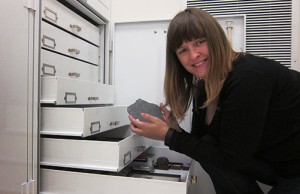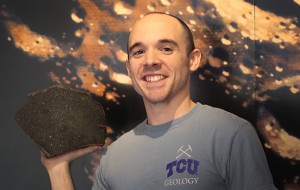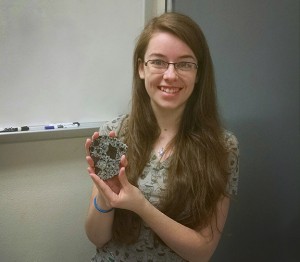The Monnig Meteorite Collection is one of the largest-university based collections in the world, providing amazing research opportunities for undergraduate and graduate students.
If you are interested in the graduate research opportunities available at TCU through the Monnig Meteorite Collection, please contact the Curator, Dr. Rhiannon Mayne.
Dr. Rhiannon Mayne – Curator
Dr. Mayne’s research is focused on understand differentiation (melting to form a core, mantle, crust structure in a planetary body), which is an extremely important process in both planetary and asteroidal formation in the early history of our Solar System. The Earth is an active planet and much of the evidence of its early history, including differen tiation, has been erased by later processes. We cannot understand the formation of our planet and its evolution through time if we are unable to reconstruct its earliest days. Planetary geologists, like Dr. Mayne, solve this problem by studying meteorites. The vast majority of meteorites come from the main asteroid belt that lies between Mars and Jupiter. Unlike the Earth and the other rocky planets (Mercury, Venus, and Mars), the asteroids, and the meteorites that derive from them, have not undergone significant reprocessing since their formation and they record the conditions and processes that were taking place in the early Solar System history.
tiation, has been erased by later processes. We cannot understand the formation of our planet and its evolution through time if we are unable to reconstruct its earliest days. Planetary geologists, like Dr. Mayne, solve this problem by studying meteorites. The vast majority of meteorites come from the main asteroid belt that lies between Mars and Jupiter. Unlike the Earth and the other rocky planets (Mercury, Venus, and Mars), the asteroids, and the meteorites that derive from them, have not undergone significant reprocessing since their formation and they record the conditions and processes that were taking place in the early Solar System history.
Dr. Mayne primarily studies the mineral makeup (mineralogy) and geochemistry of asteroidal meteorites, but also incorporates both laboratory-collected spectra, and ground-based telescope data into her research. These datasets allow her to take a multi-disciplinary approach to understanding the question of how differentiation progressed in the early Solar System.
Samuel Crossley – M.S. Graduate Student
Sam is studying the petrogenesis of Stannern-trend eucrites using experimental petrology. Eucrites are basaltic rocks presumably from the surface of the asteroid 4-Vesta, the Stannern- trend eucrites possess anomalous geochemical features that suggest that they are not products of simple petrogenetic processes, such as fractional crystallization or partial melting of chondritic precursor. In their GCA paper, Barrat et al. (2007) suggested that Stannern-trend eucrites could be produced via a partial melting of a eucritic crust, with the partial melt then assimilating with a eucritic magma chamber. We are utilizing experimental and analytical apparati in a collaborative effort with the Smithsonian Institution and other academic organizations in order to perform melt experiments and test the assimilation theory.
trend eucrites possess anomalous geochemical features that suggest that they are not products of simple petrogenetic processes, such as fractional crystallization or partial melting of chondritic precursor. In their GCA paper, Barrat et al. (2007) suggested that Stannern-trend eucrites could be produced via a partial melting of a eucritic crust, with the partial melt then assimilating with a eucritic magma chamber. We are utilizing experimental and analytical apparati in a collaborative effort with the Smithsonian Institution and other academic organizations in order to perform melt experiments and test the assimilation theory.
Julia Gregory – M.S. Graduate Student
For Julia’s thesis, she is working with the ungrouped pallasite Choteau. Pallasites are one of the most beautiful groups of meteorites, characterized by having both silicate and metal phases. After its discovery in 2011, Choteau was labeled as ungrouped due to its unusual chemistry that was different from the established pallasite groups. She has been working with this meteorite for more than a year now, throwing every test and analysis at it to figure out how Choteau fits in with the rest of the pallasites. Thus far, we have found a mineral only seen in a pallasite once before, and have potentially grouped Choteau with two other unclassified pallasites to make a new subgroup.
was different from the established pallasite groups. She has been working with this meteorite for more than a year now, throwing every test and analysis at it to figure out how Choteau fits in with the rest of the pallasites. Thus far, we have found a mineral only seen in a pallasite once before, and have potentially grouped Choteau with two other unclassified pallasites to make a new subgroup.






